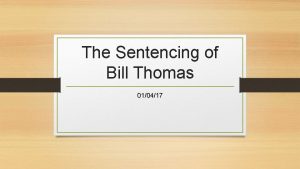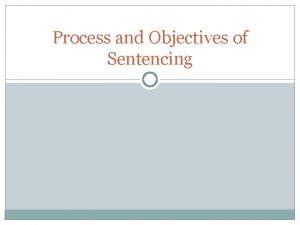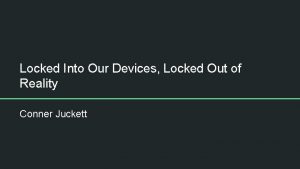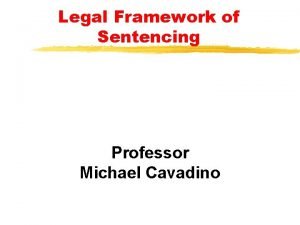SENTENCING How Long Are You Getting Locked Up





- Slides: 5

SENTENCING How Long Are You Getting Locked Up For?

Sentencing Options ◦ Suspended Sentence – A sentence is given but does not have to be served unless the defendant is arrested again or otherwise violates probation. ◦ Probation – The defendant is released, but for a certain period of time (up to five years) they have to check in daily or weekly with a probation officer, and meet certain conditions: getting and keeping a job, passing random drug or alcohol tests, staying in school, or combinations of those and other conditions. ◦ Home Confinement – Popularly known as “house arrest”. The defendant serves the sentence at home and cannot leave except for work or school. Oftentimes the sentence is accompanied by wearing an electronic monitoring bracelet. ◦ Fine – An amount of money paid to the court (or anther part of the government).

Sentencing Options ◦ Restitution – An amount of money paid to the victim or the victim’s family. Not to be confused with a fine. Often this goes along with probation or some other punishment. ◦ Work Release – The defendant lives at home and goes to work during the week, but spends weekends in jail. ◦ Imprisonment – In some states a hard number is given (”Five years in prison”). In other states, a range is given (”Not less than ten, but no more than twenty years in prison”). Early release through good behavior or time off for time served is usually available either way. Also, the time in jail waiting for the case to begin (if the defendant wasn’t out on bail) counts toward the total sentence. ◦ Death – The death penalty is still on the books in more than half the states, but is used most frequently in Southern and Western states.

More Terms ◦ Presentence report – A report prepared for a judge by the probation department after the defendant is examined by a psychiatrist. It goes over a number of issues, but the purpose is to recommend a sentence to the judge. The prosecution and defense teams also recommend a sentence, but usually a judge can do whatever they want, except for… ◦ Mandatory Minimums – A big thing in the late 1980 s that is slowly starting to go away, these were laws passed by state legislatures dictating specific punishments for specific crimes (usually drug crimes). ◦ Parole – Early release from prison at the decision of a group of appointed officials known as the parole board. Once on parole, the offender is treated as if on probation. Sometimes they live in a “halfway house” before living in the general public. As much as 3% of the entire American adult population is out on parole.

Death Penalty ◦ Only for first-degree murder, or treason in a Federal case (extremely rare) ◦ Usual methods: ◦ Current: only lethal injection and firing squad (Utah) are legal ◦ From 1940 s-1980 s the gas chamber was the most common method ◦ From 1900 s-1940 s the electric chair was the most common method ◦ Before the 1900 s hanging was by far the most common method









